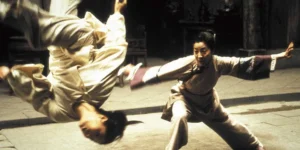Tai Chi sword is a Tai Chi weapon, combining characteristics of both Tai Chi and sword forms. It is one of the four Tai Chi weapons. The Tai Chi sword’s structure includes the blade, hilt, guard, pommel, and tassel.
Practicing Tai Chi sword can improve balance, strengthen muscles and bones, enhance flexibility, stabilize joints, and maintain a calm mind. In other words, through continuous, whole-body movement, harmony between body and mind can be achieved.

If you’re a Tai Chi beginner, you should learn more about the Tai Chi sword, as the sword and Tai Chi are inseparable.
Tai Chi Sword History
Tai Chi Sword’s history begins long ago in China, around the same time Tai Chi itself was created.
In ancient warriors and wise healers living in mountain temples over 400 years ago. These early masters didn’t just practice empty-hand Tai Chi—they also used weapons like the straight sword, called “Jian.” This sword was special: lighter and quicker than heavy battlefield swords, designed for precise moves and self-defense. At first, these sword skills were secret, passed down only within families or to trusted students. The Chen family, who created the first Tai Chi style, included sword techniques in their training from the very beginning. They believed the sword helped focus the mind and refine body movements.
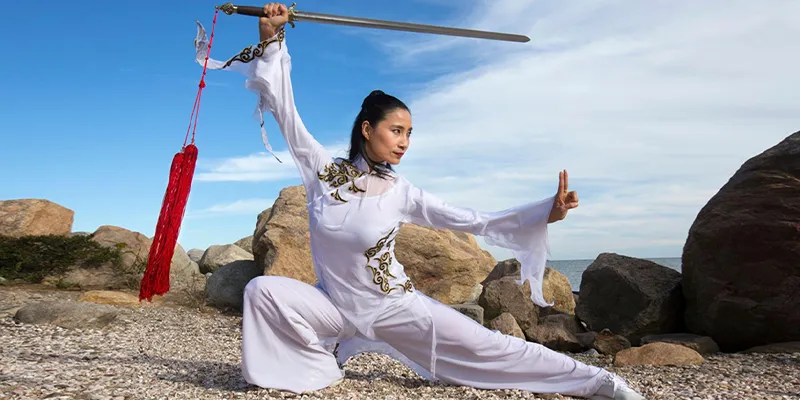
By the 1800s, Tai Chi Sword started changing. A master named Yang Luchan learned the Chen family’s art and adapted it. His version, Yang Style Tai Chi, made the sword forms smoother and more flowing. This is when Tai Chi Sword became popular outside hidden schools. People in cities like Beijing practiced it not just for fighting but for health and meditation. Books and drawings explaining the techniques began to appear. Famous masters like Wu Yuxiang and Sun Lutang added their own ideas, blending sword moves with other Chinese martial arts. For example, Sun Style integrated quick steps and sudden strikes, making the sword dance-like yet practical.
In the 1900s, Tai Chi Sword faced challenges. Wars and cultural changes threatened to erase old traditions. But masters fled to places like Hong Kong or Taiwan, keeping the art alive. They began teaching foreigners, and by the 1970s, Tai Chi Sword reached Europe and America. Modern teachers then created standardized forms so everyone could learn the same basics.
Today, it’s practiced worldwide—in parks, schools, and even online. While some still use it for self-defense, most people treasure it as moving meditation. The sword’s graceful arcs teach balance and patience, just like they did centuries ago in China’s misty mountains.
Tai Chi Sword Styles
Tai Chi Sword is practiced through distinct family traditions; understanding these styles helps appreciate the art’s rich diversity:
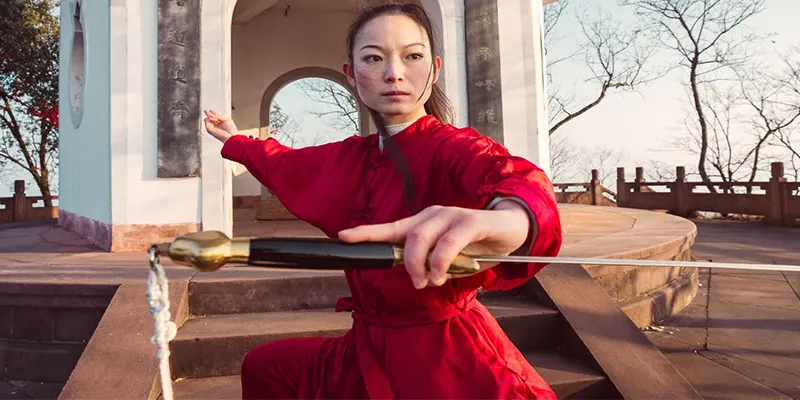
Chen Style Tai Chi Sword is the oldest and most martial-rooted form. Developed in Chen Village, it features vigorous spiraling actions generated from deep stances and explosive bursts of power integrated with softer flows. Movements alternate between slow-motion control and sudden strikes, reflecting its combat origins. The chen tai chi sword work includes low sweeps, rapid directional changes, and distinct shaking vibrations transmitted through the blade. Practicing Chen Style builds significant leg strength and dynamic coordination, preserving the original warrior spirit of Tai Chi.
Yang Style Tai Chi Sword, derived from Chen but popularized globally, emphasizes graceful, expansive movements ideal for health and accessibility. Its postures are higher and more upright than Chen’s, with smooth, continuous arcs executed at an even, moderate pace. Yang Sword has fluid transitions over combat speed, making it exceptionally meditative. The techniques—like wide horizontal slices and elegant upward deflections—flow like calligraphy in motion. This style’s gentle yet precise structure makes it perfect for beginners and those focusing on relaxation, balance, and joint health.
Wu Style Tai Chi Sword is characterized by compact, subtle motions and a constant forward-leaning posture. Movements are smaller and more vertical, emphasizing precision over range. Practitioners maintain a tight center of gravity, using minimal upper-body rotation to execute efficient deflections and precise stabs. The footwork is exceptionally nimble, with quick micro-adjustments. This style trains deep internal focus, demanding acute sensitivity to weight shifts and blade alignment, making it ideal for developing refined body awareness and patience.
Sun Style Tai Chi Sword blends Tai Chi with elements of Xingyiquan and Baguazhang, creating a distinctly agile, evasive approach. Its signature “open-close” footwork involves smooth heel-toe transitions and frequent directional changes, resembling a light stepping rhythm. Sword techniques synchronize seamlessly with these steps, emphasizing redirection and angled counter-thrusts. Sun Style feels exceptionally light-footed and adaptable, making it excellent for improving mobility, timing, and adaptability—both physically and mentally.
Wudang Sword, while not a “family style,” represents the Taoist monastic tradition. It integrates meditative qigong with flowing circular patterns, often performed at a slower, more deliberate pace for spiritual cultivation. Movements mimic natural elements—swaying like bamboo or arcing like a bird’s wing—and emphasize breath-sword harmony. Though containing martial applications, its primary focus is tranquility, energy circulation, and embodying Taoist principles of softness overcoming hardness.
All styles share core Tai Chi Sword traits: whole-body power, mindfulness, and the balance of yin and yang.
Basic Tai Chi Sword Forms
Tai Chi sword mainly includes 13 forms, including pointing, stabbing, chopping, sweeping, leading, pulling, intercepting, wiping, lifting, striking, hanging, supporting, and blocking.
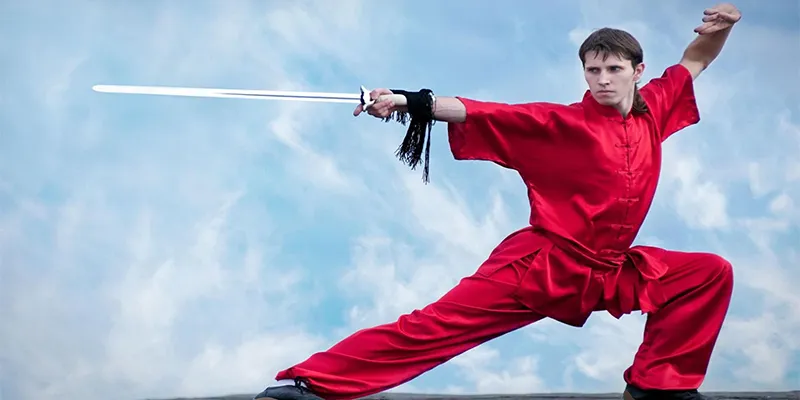
(1) Pointing the sword:
The hand holding the sword uses the wrist to exert force, focusing the force on the tip of the sword, and uses the front part of the sword blade on the side opposite to the tiger’s mouth to peck from top to bottom. It mainly attacks the opponent’s wrist or shoulder arm holding the sword, such as the “side-step sword pointing” style and the “empty step sword pointing” style.
(2) Stabbing the sword:
Use the legs, waist, and arms to exert force, focusing the force on the tip of the sword, and use the tip of the sword to directly penetrate the opponent’s vital parts. If divided by the shape of the sword, there are horizontal thrusts (the sword spine is upward or downward, and the sword blade is horizontal to both sides), vertical thrusts (the sword blade is upward or downward), and thrusts (rotating the wrist to exert force so that the sword tip spirals forward). If divided by the position of the sword, there are upward thrusts, downward thrusts, oblique thrusts, and reverse thrusts.
(3) Chopping the sword:
Use the waist and the entire arm to exert force, reaching the middle and front parts of the sword blade on the side opposite to the tiger’s mouth, and exert force from top to bottom. Such as the “independent swing chop” style and the “reverse chop” style.
(4) Sweeping the sword:
With the palm facing upward and the blade flat, use the power of the waist to sweep the blade horizontally from side to side at a low position. The range of motion is large, and it is an action to attack the lower body. (5) Sword Sweeping: This is a move that uses defense as an attack. The forearm rotates outward or inward, and the force is applied to the outer edge of the sword, causing it to move from front to back or diagonally. Examples include the “rightward horizontal sweep” and “turning diagonal sweep.”
(5) Leading the Sword:
This is a move that uses defense as an attack. The forearm rotates outward or inward, focusing on the outer edge of the sword, causing it to cut from front to back or diagonally. Examples include the “rightward horizontal draw” and the “turn and diagonal draw” styles.
(6) Pulling the Sword:
It is a defensive action. Bend the elbow joint, with the force on the blade, and use the blade to draw back from front to back or left to right. Such as the “step back and draw” style, “turn around and draw” style, etc.
(7) Intercepting the Sword:
It is a defensive action. Use the arm and wrist to apply force, and the force point is transferred from the back end or middle part of the blade to the front, which has the effect of cutting or chopping. Such as the “empty step down cut” style.
(8) Wiping the Sword:
Defend and attack. Use the sword blade to wipe horizontally from front to back or from left to right, with the force on the sword blade. Such as the “rotating flat wipe” style.
(9) Lifting the Sword:
It is an offensive action. Use the middle or front part of the sword blade on the opposite side of the tiger’s mouth to apply force, pull the wrist upward, and move from bottom to front or up to cut. Such as the “left empty step lift” style, “right bow step lift” style.
(10) Striking the Sword:
It is an offensive action. With your palm facing upward, strike forward with the tip of the sword facing the base of your palm, concentrating the force on the front of the sword. This is similar to the “step back and counterattack” style.
(11) Hanging the sword:
This is a defensive action, which can be left or right. With the base of your palm, apply force backward, reaching the tip of the sword, and then hook it back from front to back, toward the lower right (left) side of your body.
(12) Supporting the Sword:
This is a defensive move. Extend your upper arm and use the sword body (blade) to lift the sword from the bottom up, with the force being on the middle and back of the blade. For example, the “Independent Flat Support” style.
(13) Blocking the Sword:
This is a defensive move. Use the sword blade to push forward from the back, or push from the bottom up. For example, the “Right Bow Step Block” style.
How To Choose Your Tai Chi Sword?
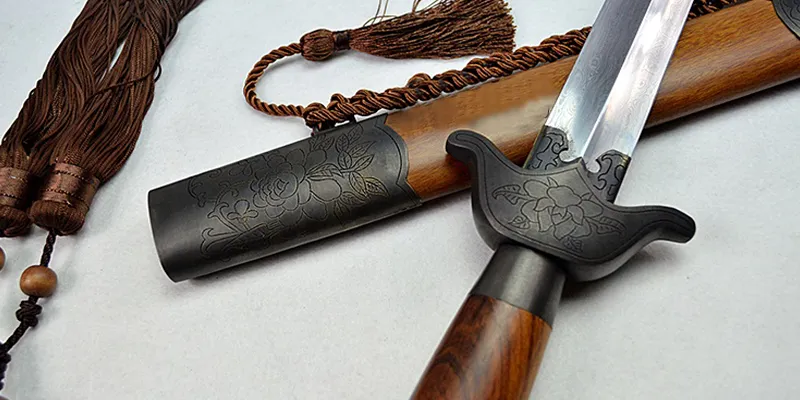
Tai Chi Sword
First, for Tai Chi sword practice, it’s best to choose a standard sword—a long sword with a scabbard. However, there are many sword styles, and when choosing, consider the following criteria:
- First, the weight of the blade, hilt, and butt should be balanced. You can use your right index and middle fingers to hold the blade about 1 inch from your fingers. If the Tai Chi sword is balanced, it’s suitable.
- Second, the tip of the sword should barely bend when placed on the ground. If you can place the tip of the sword on the ground and release it, and it remains upright the moment you release your grip, it meets the criteria.
- Third, the blade should have a 90-degree bend stiffness. You can bend the tip of the sword with your fingers. If you can bend it to a 90-degree angle and it doesn’t go much higher than that, it’s considered the ideal size. A sword that’s too soft or too hard is not suitable.
- Fourth, hold the sword in the starting position of Tai Chi sword, holding it against the back of your arm. If the tip of the sword is above your earlobe but below your eyebrows and eyes, it’s the right size.
- Fifth, a standard Tai Chi sword weight is generally around 600 grams. The weight of the sword will vary slightly depending on the body size, but the deviation is usually within 100 grams.
Scabbard
Pearwood is the best material for a scabbard. Traditional Longquan swords are made of pearwood. Pearwood scabbards offer the following advantages:
- Beautiful color and grain.
- Fine texture, strong, and durable.
- With age, the wood’s color deepens and becomes more lustrous.
Material
Sword blades are typically made of stainless steel or carbon steel. Stainless steel is the most commonly used material, as it resists rust and is easy to maintain.
Sheng Jiangfei Tai Chi Sword and Forms
Today, our Tai Chi school offers experienced teachers, a beautiful and peaceful environment, and reasonable prices. You can learn various moves from experienced Tai Chi masters. Welcome you to learn more about us.



